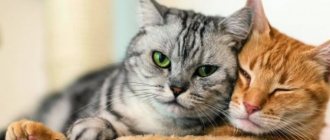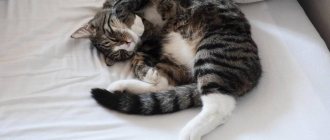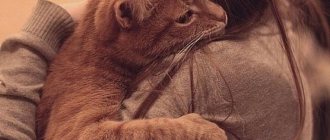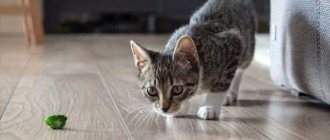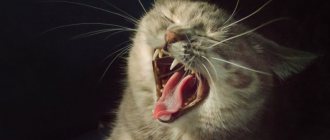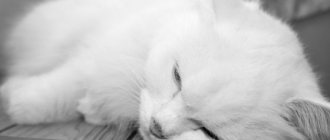What do cat marks look like?
Cats approach any vertical object, straighten their tail and lift it. At this time, a small amount of urine is released. Sometimes cats can change their position, but the main sign of a mark is the release of a very small amount of liquid, no more than 1 ml.
The cat marks the territory
Cats, unlike cats, do not excrete urine to mark their territory, but rather rub their faces against certain objects. Often, owners think that in this way the cat is showing affection or wants to be paid attention to, but here everything is much more complicated. There are special glands near a cat's eyes. They emit a specific smell that humans cannot smell, but other animals immediately begin to understand that the place is occupied.
Among other marks of cats, it is worth noting the sharpening of claws. There are also small glands on the paws of cats, and when they tear objects, they leave a mark wherever they need to. In this case, a person does not feel the smell, but the visible trace is obvious.
Cat mark on the floor
Another way cats mark is by secreting saliva, but this mark does not carry any information.
How is marking different from urination?
When cats begin to mark, they leave the smell of urine in the room or rub their faces against the furniture, leaving behind an odorous trail from special glands located near the eyes and on the paws.
How to stop a cat from marking territory in an apartment
If a cat rubs against furniture, then in this way she makes it clear that she is calm in this house and she feels protected. Marks left by urine are a kind of manifestation of aggression and thus, a cat shows its rights to own a particular territory.
Important! Basically, this reaction occurs in connection with the appearance of another animal in the house or as a result of a change in the usual environment.
Most owners are concerned with the question of how to distinguish a territory mark from arbitrary urination past the tray. If the cat just wants to go to the toilet, then she does it while sitting. If it leaves a mark, it does so while standing on all fours, lifting its tail up and leaving a small amount of liquid. This behavior is typical not only of cats, but also of males, especially during sexual desire.
Marking is most often done with a stream of urine, but there are other methods of marking in cats that are also serious behavioral disorders and are difficult to distinguish from location preference.Marking without spraying
. Cats mark their territory with urine—either by spraying a stream of urine or leaving puddles—or with feces. Large wild cats mark the boundaries of their territory in all these ways. Domestic cats may leave marks in one or more places. Without understanding the complex social structure of their community, the tagging problem cannot be resolved. If outside cats leave puddles of urine and feces near only one door, this indicates that they are likely engaging in marking behavior without spraying. In the same circumstances, marks can also be made with a jet, but for some reason veterinarians rarely diagnose marking without spraying with a jet, i.e. underestimate the frequency of such cases. It is not uncommon for no-spray marks to be misdiagnosed as intractable or intractable substrate or site preference. If the owner notices changes in the relationships of cats living under the same roof or changes in visits from outside cats, then marking without spraying should be the first on the list of possible diagnoses. The hypothesis of substrate or site preference can be tested using one of the methods described above. If these steps do not resolve the problem, knowledge of the relationships of cats in the community will allow the veterinarian to determine whether marking is occurring without urine spraying.
Marking with puddles of urine without spraying is a trait inherited by cats from their wild ancestors; the same applies to excrement marking. We have no evidence that in domestic cats there was any selection against the desire to mark.
Urine stream marking
. This is a feature of normal cat behavior in a variety of situations. Spraying urine in domestic cats is both part of the elimination process and part of normal social interaction. This is a dimorphic behavior, more characteristic of males than females. Such dimorphism can be explained by unequal sex ratios in the community, found, for example, in lions (Bertram, 1975; Macdonald, 1983), as well as in free-ranging and domestic cats (Beaver, 1981d; Hart, 1975; Macdonald and Apps, 1978). Of the cats that spray-marked and were castrated, 10% of the animals continued to do so after the operation, and of the females that had previously spray-marked, only 5% continued this after the operation (Cooper, Hart, 1992; Hart, Barrett, 1973; Hart, Cooper, 1984 ). However, statistical processing of the initial data shows that the decrease in urine marking after castration is the same in both sexes (p>0.05; F = 2.568). This suggests that the desire for such marking is modulated not only by gender. In fact, despite the dimorphism of this behavior, it is generated more by social reasons than by gender. Veterinary medicine underestimates the dependence of this dimorphic behavior of cats on the state of intragroup relationships.
The problem of marking in the home cannot be resolved if one ignores the social situations in which the animal finds itself (Hart and Cooper, 1984; Hart et al., 1993). Cats that are not outside, but who are visited by street animals, sometimes begin to mark windows and doors with a jet, especially if visitors do the same.
A similar situation can arise at home. Strong, energetic cats usually announce their presence or status by spraying marks everywhere. Less confident cats often try to create a niche for themselves by leaving urine marks, excrement or puddles in a specific location. When faced with open aggression, if such cats resort to marking, they mark with a stream after a conflict, since due to their temperament they do not dare to get involved in a fight. The role that tagging—by spray and other means—plays in various social contexts has never been thoroughly examined. Theoretically, spray marking should occur less frequently in confident animals, but research in feral cats has shown that both the visual and olfactory components of the display are important to community members when spray marking occurs. With cats kept indoors, the situation appears to be more complex. To eliminate marking behavior in the home, it is necessary to carefully study the animal's entire social network. Since both female cats and female cats are capable of urine marking, it is important to consider that both may experience anxiety related to social relationships. Signs of anxiety include pronounced autonomic reactions (heartbeat and dilated pupils in the presence of another cat), increased motor activity (walking or attempts to escape when another cat appears in the field of view or approaches) and the alert state of the animal, carefully monitoring everything that is happening. It should also be taken into account that representatives of both sexes mark with a stream of urine either in order to make themselves known, or as a threat or response to a threat. The occurrence of such unwanted behavior largely depends on the social system of the cats living in the house.
Clients often confuse marking with urination. It is important that they are able to describe the cat’s postures and mark the places where marks are left. Having learned to notice the characteristic pose of a cat standing still with a raised, quivering tail and a stupid or enthusiastic expression on its face, they will know that at this moment it is marking with a stream of urine. Clients should also be advised that cats, especially confident cats, may exhibit spray marking behavior without excreting urine. Often, when marking with a jet, cats shift on their front paws, as if kneading dough; it is assumed that this is how they mark the territory with the secretion of the interdigital sebaceous glands. A directed stream of urine hits vertical surfaces and flows down them. Owners should carefully inspect the backs of chairs, sofas and walls just above the baseboards. It is advisable that they search, maybe even crawling around the house on their knees, for marked places using their sense of smell and touch. The absence of marks on vertical surfaces does not mean that the cat does not mark with a jet.
. She may stand in the middle of a horizontal surface, such as a bed, and release a stream of urine. This leaves a long, narrow wet streak rather than a round puddle. The owner must carefully examine every inch of the carpet. If only a puddle in the middle is found, then it is unlikely that the cat is leaving marks with a stream of urine.
Jet marking
As a rule, jet tagging responds best to treatment in cases where social
animal environment. Modification of the environment and behavior should be carried out in combination with the use of pharmacological agents. If you focus only on modifying behavior and the physical environment, jet tagging cannot be stopped; The only exceptions are cases when it has just arisen and has not yet become habitual. Thus, if jet marking is episodic, or if it has just appeared and it is known what exactly triggered it, then modification of behavior and environment may be sufficient; however, if there is no improvement within the first week, then drug treatment should be started as soon as possible. This is important for two reasons. First, olfactory cues are important to cats, so each time they mark, the olfactory stimulation reinforces the skill. Secondly, other cats do not remain indifferent to such demonstrations, and as a result, the existing hierarchical structure of the group begins to collapse.
For the drug treatment of various forms of marking behavior, the following drugs are mainly used: TCAs, namely amitriptyline (Elavil), nortriptyline (Pamelor) and clomipramine (Anafranil, in Russia - Clomex is under development and testing); benzodiazepines, in particular diazepam (Valium); nonspecific anxiolytics – buspirone (buspar). Currently, there is no reliable data on the effectiveness of other nonspecific anxiolytics in such cases, for example fluoxetine (Prozac, in Russia - fluex is under development and testing). However, their successful use in the treatment of other behavioral disorders in dogs and cats (Overall, 1995) suggests that they will also be effective in cases of unscrupulous behavior in cats. Traditionally, diazepam is preferred. It has been used to treat tagging for over 10 years with varying degrees of success.
When used correctly, diazepam can control marking behavior in cats in 75-90% of cases (Marder, 1991). The drug is prescribed in the following doses: 1.0-3.0 mg per cat orally 1-2 times a day (Houpt, 1991b; Marder, 1991) or 2-4 mg per cat orally 2 times a day (Cooper, Hart, 1992 ). To relax skeletal muscles in FLUTD, it is given in doses of 1.25-2.5 mg per cat orally 1-2 times a day (Osborn et al., 1987). Typically, cats treated with diazepam will experience a slightly unsteady gait and impaired depth perception for a few days. The staggering resolves spontaneously after about 7 days. Some cats need to be given diazepam for a few weeks, others seasonally, and some for life. The minimum effective dose should be used. Some cats that respond to diazepam need to be given a benzodiazepine with a longer half-life, such as chlorazepate (dipotassium salt) (Tranxen-SD) 0.5-1.0 mg/kg PO 1-2 times daily or 0.55- 2.2 mg/kg PO as needed. If the cat does not respond to treatment with diazepam, these prescriptions may also not give the expected result.
It is important to understand that tagging behavior is caused by a variety of reasons. This has already been mentioned above, but I want to emphasize it again. Unsuccessful drug treatment sometimes allows one to formulate a testable hypothesis about which neurochemical mechanisms underlie the behavioral disturbances leading to tagging. Finding out relationships between cats is a difficult and thankless task. However, understanding the social status of the animal can be the key to prescribing the right drug, although erroneous prescribing can provide important information. This further emphasizes the importance of taking a thorough behavioral history of the cat; if the prescribed medicine does not give the desired result, look for an explanation in the anamnesis. It is necessary to persistently test the stated hypotheses in practice and draw correct conclusions from this - this is the only way to achieve success in the field of behavioral medicine.
Recently, buspirone has become widely used instead of benzodiazepines for the treatment of jet marking. In some cases this gives good results. Statistical analysis of data from various studies (Hart et al., 1993; Marder, 1991) showed that buspirone is no more effective than diazepam, but treatment is significantly more expensive. If diazepam is given 1-2 mg (0.2-0.4 mg/kg) orally 1-2 times a day (initial dose = 1 mg 2 times a day), then the dose of buspirone is 5 mg orally 1-2 times per day (initial dose = 5 mg 1 time per day). Since long-term treatment with buspirone is usually required - 6 to 12 months - its cost is significant. The costs would be justified if the drug were exceptionally effective, but statistical data processing did not confirm this.
Practice shows that after stopping treatment with diazepam, relapses often occur. When resuming treatment, the dose of this drug must always be increased. In some cases, tagging behavior cannot be re-treated. However, there is no reliable data (obtained from large samples) on issues such as assessing the emerging refractoriness of cats to the action of diazepam and the degree of dose increase when it is repeated, so additional research is required here. Decreased response to the drug is most likely due to the development of physiological dependence (File, 1990).
Physiological dependence is not a problem for animals, perhaps because they cannot self-administer medications. Benzodiazepines are dangerous in this regard for humans, and clients giving these drugs to their pets should be warned about this. Because jet marking often requires long-term maintenance treatment, your veterinarian should be careful not to prescribe large quantities of the drug at once. It is best to write a new prescription every month or two during client visits. This will also make it possible to constantly update the medical history with new data about the patient. The recurrence rate of jet marking is quite high. This probably depends to some extent on the lack of attention to the problem of social relationships. Marder (1991) and Hart et al. (1993) reported different data on relapse rates after treatment with diazepam. Recent authors (based on the work of Cooper and Hart, 1992) report that after discontinuation of diazepam, 10 out of 11 cats under observation (95%) resumed jet marking, while Marder (1991) indicates that marking resumed after some time. time in only 13 of 17 animals (75%). In the case of buspirone treatment, relapses, as observed within 8 weeks after complete discontinuation, occurred in 17 of 32 cats (53%). The difference in the given data (13 out of 17 and 17 out of 32) is statistically insignificant (F=2.56; p>0.05). Hart et al. (1993) did not specify the timing of diazepam dosage reduction or dosage regimen.
Both the time at which the drug dose is reduced and the treatment regimen are important for a comparative assessment of the risk of relapse. Thus, the data discussed relate only to an 8-week observation period after treatment with buspirone, and therefore, the detected relapse rate is most likely underestimated. This is further supported by the fact that in both humans and dogs, therapeutic blood levels of buspirone are achieved only after 2–4 weeks of treatment (Marder, 1991; Robinson et al., 1989). Since clearance is also usually delayed in such cases, estimates of relapse rates over a short period of time are clearly unreliable. Thus, it remains unclear which drug produces more relapses. However, since buspirone, unlike diazepam, does not affect short-term memory and is also thought to affect the serotonin and dopamine systems of the brain, it may well be able to normalize social interactions in cats and reduce the intensity of marking based on agonistic behavior.
The main reason for the use of buspirone in the treatment of jet marking is the recent reports of cases of fulminant liver failure and death in cats treated with low doses of diazepam (Center et al., 1996; Hughes et al., 1996). Doses were reported to be no more than 1 mg per cat, and both international (diazepam) and brand name (Valium) drugs were used. Unfortunately, the available epidemiological data are insufficient to make assumptions about the cause of diazepam intolerance in individual animals. A recent reanalysis of the response of cats to diazepam and autopsy data from animals treated with it showed that their sudden death could only have been caused by an idiosyncratic reaction (Hughes et al., 1996). The majority of cats that died suddenly were overweight, suggesting that accumulation of active metabolites in adipose tissue may be important (Center et al., 1996). Therefore, it is prudent not only to make clients aware of unexpected effects that have occurred, but also to inform them that such cases are no more common than an idiosyncratic reaction to phenobarbital in dogs. The best preventative measure is not to prescribe any medications until a thorough clinical examination and hematological and biochemical blood tests have been obtained. It remains unclear whether such idiosyncratic reactions are the result of heredity-environment interactions or virus × drug interactions, or whether they are a liver response mediated by the immune system. Since preliminary blood tests were done on only a few of the dead cats, it cannot be ruled out that these animals had some kind of disease.
Buspirone is a nonspecific anxiolytic that acts as a partial agonist of 5-hydroxytryptamine (serotonin, 5-HT) at the pre- and postsynaptic levels (Coop and McNaughton, 1991; Lucey et al., 1992; Robinson et al., 1989). It has also been suggested that buspirone is a dopamine receptor agonist (Lucey et al., 1992). Any serotonin or dopamine agonists can reduce anxiety caused by a sense of danger in some social situation; Reducing anxiety allows the animal to behave more socially appropriately. Depending on whether marking is a signal or an act of aggression, the use of buspirone will be more or less effective. Aggression - and jetting can be an act of aggression (Overall, 1994e, k, l, m) - is a very complex behavior, and it is not surprising that even similar pharmacological agents have different therapeutic effects. The effects of all compounds used must be carefully studied.
Treatment of fear, phobias, and social anxiety with tricyclic antidepressants (TCAs) has shown promising results (Rang et al., 1995). This group of drugs is diverse, but most of them enhance the effect of serotonin. Older short-acting TCAs, such as amitriptyline, have been effective in treating uncleanliness caused by aversion and unwanted preferences. In cases of spray or non-spray labeling, they have rarely been used, although amitriptyline, for example, is available in an easy-to-take liquid form. If social anxiety is mild or recent, “low-tech” (older) TCAs may be recommended to treat tagging. Amitriptyline is still considered the drug of first choice for the treatment of FLUTD, or sterile cystitis (Buffington et al., 1993; Eschalier, 1990; Fromm et al., 1991; Hanno et al., 1989). It is prescribed primarily because, due to its effect on the level of norepinephrine in the brain, it helps resolve inflammatory processes of neurogenic origin. At the same time, it is impossible to exclude such an effect of amitriptyline as a weakening of the anxiety state caused by pain.
Clomipramine (Anafranil, in Russia - Clomex is under development and testing), a relatively specific serotonin reuptake inhibitor, has only recently become used for the treatment of labeling, so there is still insufficient data on its effectiveness. It appears to be equally effective for cats living alone as well as for animals in a group, as well as in situations where anxiety does not respond to other treatments. There are no data on the use of clomipramine for the treatment of marking during sexual displays. In humans and dogs, therapeutically effective levels of clomipramine are achieved after only 4-6 weeks of treatment, but in cats it acts more quickly and its effects begin to appear in the first week. Cats are more sensitive to the side effects of any medications than dogs or humans. Compared to most other drugs, the newer drugs, including clomipramine, have milder side effects, but there is no accurate data on their toxicity yet.
If cats do not respond to the medications listed above, progestins can be used (Beaver, 1992c; Chesney, 1976; Hart, 1980a), but they are used only as a last resort due to the risk of side effects such as gynecomastia, diabetes mellitus, breast neoplasia, suppression of bone marrow function. Progestins are never prescribed to breeding animals. Under no circumstances should they be prescribed without a complete clinical and biochemical blood test and subsequent repetition of these tests every 6-8 weeks. Clients should be warned about all possible side effects of medications, as liability issues may arise. It is advisable to obtain a document of informed consent or release from liability from the client. In all cases, without exception, clients should be provided with all available information about the possible risks associated with the use of any medicine.
What should you consider when choosing one medicine over many others?
Diazepam and progestins affect jet marking behavior through the central nervous system through two independent pathways. Progestins bind to cytosolic androgen receptors and have a direct inhibitory effect on steroid 5a-reductase[1] in hypothalamic and limbic system neurons (Gupta et al., 1979; Henik et al., 1985). Diazepam is very useful in situations where quick results are needed, such as when the client needs to notice changes in the animal's behavior within a week. In case of relapse, diazepam can be reused, but it is better to warn the client that a higher dose will have to be prescribed. Let me repeat: a small proportion of animals are insensitive to this drug, although it is still unknown what this proportion is - we still need to work on this. However, if a cat has relapsed due to exposure to the same social stimulus that previously triggered the unscrupulous behavior, and diazepam has already helped once, it will help again. Sometimes diazepam is preferred because it is a cheap drug. Of course, no drug should be prescribed based on cost alone, although some clients prefer treatment with an expensive drug, especially after a cheap one has failed.
Buspirone has been used successfully in cases where the primary behavioral disorder is aggression, when the cat is very self-confident, or when the cat lacks self-confidence and is unable to win a place in the group. The positive effect of buspirone in such cases is explained by the fact that it facilitates social contacts and the establishment of hierarchical relationships. The drug is effective in the following situations: 1) with active but hidden aggression in combination with marking behavior (of any type); 2) with aggression associated with hierarchical status and combined with jet marking (buspirone promotes the establishment of normal hierarchical relationships and reduces the level of open aggression); 3) when tagging in the case of passive aggression, when the client understands that the cat should become more confident - this trait is useful when building relationships in a group of cats.
Buspirone is used when a drug with a long half-life is required, and price does not matter. If the cat is expected to require maintenance therapy, it is better to use buspirone rather than diazepam, as the latter is physiologically addictive in humans. In addition, buspirone does not cause addiction in humans. It is also prescribed in cases where TCAs and benzodiazepines are ineffective or the cat does not tolerate them well. Buspirone is chosen first if it is necessary to treat aggression, but it is important to determine the type of aggression and to what extent it is open or hidden. Buspirone is effective in all of these situations, but it can also make a cat who was previously a latent threat more self-confident and open to interactions. This will be a positive effect only on the condition that behavior modification and monitoring of animal relationships are carried out simultaneously with drug therapy. Box 8-7 provides examples of how drug selection occurs.
If there are aggressive interactions between two cats and one of them is completely terrorized, treatment with diazepam should weaken her short-term memory of fearful events and make her more friendly. At the same time, the aggressor needs to be prescribed buspirone: it will free the animal from the feeling of anxiety associated with aggression, which will help normalize the relationship between these two cats. In this situation, it is important that the aggressor remains anxious despite the fact that the victim’s postures indicate the absence of a threat on his part, and also that aggression is the result of anxiety. What is important for establishing social relationships in cats is that the effect of buspirone on an aggressive cat will develop against the background of the effect of diazepam on another cat.
It has been noted (Hart et al., 1993) that many cats become more self-confident as a result of treatment with buspirone. It remains unclear in what context such overconfidence constitutes disruptive behavior. The logic in this case is very complex. A cat that suppresses any manifestations of aggression and is also confident in itself may have learned that aggressive behavior is disadvantageous (i.e., its owners punished it for it). In such a situation, diazepam should not be
, because he will remove prohibitions, even those that are useful. This is where a confident, actively aggressive cat that is inhibiting aggressive behavior may be better treated with buspirone rather than diazepam.
If a cat shows anxiety about its position in the hierarchy and, regardless of the response of other cats, demonstrates open aggression, thereby constantly asserting itself, then diazepam should be preferred. Buspirone can increase existing aggression, while diazepam makes such animals more friendly and eliminates their anxiety, which makes it easier to resolve social conflicts. Clomipramine also works well under the described conditions. In this situation, it is better to give buspirone to the victim of aggression, as this will make him more assertive. It must be emphasized that these drugs are not only intended to treat the initial state of anxiety, in addition, they contribute to the simultaneous modification of behavior.
So, a self-confident bully does not need to be treated with buspirone, this will make him even more arrogant. If the cat victim of aggression is completely intimidated and passive, the situation can become truly threatening. In this case, the insolent person needs to be prescribed a drug that will make him more friendly (diazepam), and the unfortunate victim needs to be prescribed a drug that will ease her anxiety and help her regain her place in the social system. Buspirone is preferable in this case because it increases self-confidence, although diazepam and clomipramine will also be effective.
We do not have data on whether the transient, mild ataxia (gait disturbance) that occurs under the influence of diazepam contributes to the restoration of social order, but this possibility should not be excluded.
Surgical methods of treatment
All animals that are spray marked should be castrated to reduce the level of sex hormones (Bali and Hormeyer, 1986; Bovee, 1985). Transection of the olfactory tract (Hart, 1981b; 1982) and transection of the ischiocavernosus muscle (Hauptman and Komtebedde, 1989; Komtebedde and Hauptman, 1990) have also been proposed as surgical treatment. Cutting the olfactory tract does not affect the cat's ability to eat, but it is no more effective than drug treatment methods, and also causes negative attitudes from owners. The last of these surgical operations gave a positive result (reduced marking of both types) in 7 of 10 castrated cats older than 6 months that were previously treated with progestins or diazepam (the cause of marking was not established).
For more information, see Karen Overall’s book “Clinical Methods for Behavior Correction in Dogs and Cats”
, published by the Sofion publishing house in 2005.
https://www.sofion.ru/catalog/detail.php?ID=1158
You can also view and order the book in our Pet Council online store at the link https://www. petsovet.ru/catalog/books/element.php?SECTION_ID=346&ELEMENT_ID=2017
[1] By binding to androgen receptors, progestins prevent the manifestation of the action of androgens, and by inhibiting steroid 5a-reductase, they prevent the formation of androgens from steroid precursors; Accordingly, both effects are aimed at reducing the regulatory impact of male sex hormones. – Approx. ed.
What time do cats start marking their territory?
How to stop a dog from marking in the apartment: what to do
This criterion is conditional, and marks left by cats can become noticeable in different ways. It all depends on the age of the animal, its character, nutrition and living conditions. According to veterinarians, on average, cats begin to leave marks from the age of eight months, because it is during this period that hormone levels rise, and the cat is looking for a way to attract a sexual partner.
For your information! The marks are accompanied not only by marks on furniture and curtains, but also by calling cries.
Also, the period when territory marking begins can be tracked by the behavior of the animal; you can observe it quite carefully. When puberty occurs, character and behavior changes, the body acquires clear outlines and becomes muscular.
During this same period, aggressive behavior towards other animals occurs. Pets often begin to mark their territory as a defense.
The cat marks the territory: the main reasons for unwanted behavior
How to stop a cat from peeing on the sofa: what to do
The smell left by a cat is a unique way of communication between animals. By leaving marks around the house or yard, they seem to show strangers that this territory has an owner and it is better not to set foot here. With the help of such marks, living in the wild, the animal provides itself with protection and the opportunity to get some food.
As for domestic animals, they also leave marks, but this already happens at the level of instinct. There are several main reasons for leaving such traces:
- puberty;
- the appearance of a new pet in the house or a change of environment;
- there is not one cat living in the house, but several;
- the owner smells of another cat;
- stressful situations, such as renovations or moving.
A change of scenery
Do cats mark territory? As we found out, yes. Moreover, they do this for reasons that the owner does not always pay attention to. Let's say that the house is being renovated. Everything changes: the usual wallpaper, furniture. For people this is joy, but for cats it is wild stress. So she begins to protest, expressing her protest with marks all over the house.
Or the owners had to move to a new place of residence along with their pet. It is possible that the cat will begin to mark corners in a new house or apartment. What is unimportant for the owners, the cat looks at it from a completely different angle.
Why does a cat mark its owner?
It is surprising not only how cats mark territory, but also why they mark their owner, who feeds them, shows care and looks after them?
There may be two options here:
- The pet is trying to challenge the rights of the owner and force him to act according to his own rules. This behavior is typical of cats or cats that came into the house as adults from the street and are accustomed to defending their place in the sun.
- In the second case, by leaving marks on the owner, the animal thus marks that it is his and no one else’s. And this is so, because someone else’s cat will never approach a “marked” person.
Pairing
In part, the marks are a way to indicate to the female cats that the male is ready to mate. Many people make attempts to match their cat with a female. However, this is not the best option, since subsequently the cat may only begin to mark the territory more often if he understands that he is given a cat every time.
If your cat pees anywhere, you shouldn't bring him a cat.
How long do cats mark after castration?
If a pet lives in an apartment and the owner wants it to stop marking its territory, then the only solution in this case will be castration or sterilization. This operation is performed during puberty.
After surgery, the animal may leave marks for some time. This is because the hormonal background of an animal cannot change in one day, but this will take about 2 months, or maybe more.
Worth knowing! If castration was carried out several years after the onset of puberty, then the desired effect may not be achieved.
Why doesn't castration or sterilization always solve the problem?
Sometimes a neutered cat marks its territory even after a long time after surgery. It continues to do this if:
- was castrated in old age and leaving marks became his habit;
- has such a feature as cryptorchidism, when one or both testicles are located not in the scrotum, as it should be normally, but in the groin area or abdominal cavity, and during the operation an inexperienced surgeon did not take this point into account;
- there are other relatives in the home - a castrated animal still has to protect its personal boundaries.
Repelling with foil, sprays and other methods
If a cat is marking its territory, what to do is a question that cannot be answered definitively. There are several methods.
You can scare away your pet by using regular foil. Basically, the animal chooses one or several places for its tracks. Having found them, you need to lay foil there. Cats do not like to touch this material because the rustling sound irritates them.
You can stop your cat from marking his territory using foil.
If you don’t have time for experiments, then you can purchase a proven product in the form of a spray, which contains cat pheromones that help improve the psychological state of the animal. You can purchase this product at a pet store.
Advice! When you have absolutely nothing at hand, you can use folk remedies, for example, lemon juice or citrus-scented essential oils. Their smell has a deterrent effect on cats.
Let's summarize
We talked about why a cat marks. Main conclusions of the article:
- The reasons for this phenomenon are different. These include: bladder problems, estrus, stress, change of environment, the arrival of a new family member.
- How to deal with hooliganism? First of all, find out the reason, and if it is not associated with diseases, then there are several options: sterilizing the cat, cleaning with special products that wean the pet off from marking, cleaning the area using available disinfectants. They kill the smell and repel the cat with their own scent.
What to do when a cat marks in the house and how to stop it
If a cat marks objects in the house, then the surest way to stop him from doing this is castration. But changes in the animal’s hormonal background will continue to occur for quite a long time. In this case, there are several effective ways, not so drastic:
- Place peels of citrus fruits, the aroma of which animals cannot tolerate, in places where there are regular marks.
- Buy a special repellent spray.
- If the appearance of marks is associated with stressful situations, you must try to eliminate them by paying more attention to the animal.
- If the cat was caught in the act of a crime, then you need to lift it by the scruff of the neck and hiss, looking into the eyes. Hold the animal until it starts meowing and averting its eyes.
Worth knowing! There is no one 100% effective way to stop marking territory, because it is a natural instinct against which animals are powerless. But the above methods will help you get rid of leaving marks at least for a while.
The cat marks in the house
New family member
The young owners of a luxurious Persian cat gave birth to a child. The pet always had a calm and kind disposition, was not problematic and visited her litter box regularly. And then they replaced her: she hides in all corners, she began to be capricious in her diet, and the worst thing is that the cat marks all the corners, including the children's room.
What should owners do in this situation? First of all, you need to know that this behavior is the pet’s reaction to the baby, oddly enough. Cats have difficulty withstanding any change of environment and the appearance of new faces on their territory. Over time, this behavior will pass. In this situation, all that remains is to punish the prankster by catching her at the crime scene.
Is it possible to wean a neutered cat from the habit of marking premises?
If the cat is neutered and still continues to mark the territory, this can be facilitated either by stress, for example, due to a change in environment, or by a complete lack of attention from the owners.
You should definitely remove traces of cat marks by wiping the area with vinegar or spraying special deodorizing agents that are sold in veterinary pharmacies. Special cat pheromones, which are currently on sale, will also help to wean the animal from marking. But before using them, you should consult a veterinarian.
Jealousy
This is true for our pets no less than for people. They are great owners, and they do not want to share their owner, as well as their home, with strangers. Therefore, the arrival of a new member of the household is often painfully perceived. If your pet has always been disciplined (especially if he has already been neutered), and now he has started marking the house, then perhaps this is his way of letting the new family member know who is boss. This may also apply to the situation of protracted repairs, when builders appear at home every day to perform various works.
Sometimes even an ordinary guest visit can cause an animal to be jealous. Especially if he sees that the owner has turned all his attention to the guest, and he was asked to leave. Today, veterinarians say that cats can even be jealous of gadgets when they see that their beloved owner spends all his time only on a computer or tablet. Again, the best way to solve this problem is to allocate your free time and attention wisely. If you have a pet, then you need to pay enough attention to it.
What to do if your cat is marking her territory during heat
A very difficult period for the owner is the moment when a cat begins to mark its territory during estrus. In this situation, you should not shout or intimidate, because such methods will not help.
It's worth using a few tips:
- Talk to the animal in a quiet and calm voice, without showing aggression.
- Pet him on the head or tummy, but under no circumstances should you touch the tail.
- To drive excess energy out of your pet, you should periodically give him different tasks, for example, catch a mouse and bring a toy.
- Give food in very small portions, but access to water should be constant.
- You can bathe your cat in warm water, but make sure that there are no drafts in the room.
All these methods calm the animal and relieve stress, as a result of which there is every chance that it will stop crap in the room.
Medicines
To calm the animal and reduce its desire, you can use medications such as:
- Cat Baiyun;
- Fitex;
- Stop stress.
Their safety is guaranteed by their herbal composition. These are proven sedatives for animals that are not harmful to health. But hormonal drugs, for example, Sex Barrier drops, are dangerous for pets. Their use often results in cancer and death. In addition, they do not get rid of marks completely.
How to find cat marks
To find a cat's mark, you can use an ultraviolet flashlight. If you turn off the lights in the apartment and turn on the flashlight, the marks left by the cat will be illuminated with green light. Thus, you won’t have to wash half the apartment, but it will be enough to eliminate only the trace left behind, which emits a cutting, foul odor.
Traces of cat marks under ultraviolet light
Rules for arranging a toilet: choosing a tray
Many cats love trays with bars that don’t get their paws dirty. It is important to rinse this tray thoroughly after each time your pet goes to the toilet. The tray can be filled with special absorbent granules. Then daily cleaning after your pet will only include removing solid waste from the litter. The granules absorb moisture and odor well, but tend to stick to the paw pads or roll out over the sides of the tray during the process of instillation. To avoid litter spillage, choose a tray with high sides commensurate with the size of your cat. The pet should be comfortable using its toilet.
Tag prevention
To prevent the appearance of marks in the house, experienced breeders and veterinarians recommend using the following measures:
- Emasculation. An effective method of preventing the appearance of marks, only if the operation is performed before the onset of puberty.
- Proper education. This is not the most effective method, because if leadership qualities are inherent in a cat’s nature, then it will be quite difficult to fight them. If the cat is obedient and flexible, then with proper upbringing everything can work out.
- Accommodation in an apartment for a female and a male. This method does not fully guarantee that the cat will stop marking its territory. In addition, there will be another problem associated with permanent offspring.
Thus, there is no 100% effective way to prevent marks in a Scotsman, Briton or other breed, but you can fight marks with the help of educational and hygienic measures.
Proper education of a male kitten
When getting a kitten, the owner must realize that it is unacceptable to let its upbringing take its course. This threatens not only with bitten hands and torn walls. When an animal reaches puberty, lack of proper upbringing can result in a desire to mark corners.
The child must understand from an early age who is the boss in the house. Permissiveness leads to incorrect behavior of a young animal during sexual hunting: screaming, aggression, marks. At the slightest disobedience, it is necessary to use light methods of punishment:
- spraying a spray bottle into the pet's face,
- noise exposure or loud voice commands.
It is important not to waste time and subject the mature kitten to the castration procedure in time, before territory marking becomes a habit. Timely castration guarantees the absence of unpleasant consequences in the form of territorial marks.
Why does a cat mark?


